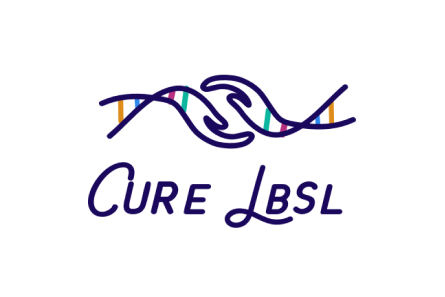CureLBSL (formerly A Cure for Ellie)
Cycle 2
Leukoencephalopathy with Brainstem and Spinal Cord Involvement and Lactate Elevation (LBSL) is a very rare and degenerative genetic brain and spinal cord disorder. It slowly robs people of their ability to walk, then stand, then coordinate all motor movements.
Last updated May 2024
Clinical
Disease Class
Rare Mitochondrial Disease
Rare genetic diseases
Rare inborn errors of metabolism
Rare neurological diseases
Rare, congenital, progressive multi-system disease
Body Systems
Metabolic
Nervous / Sensory
Organs
Brain
Nerves
Spinal cord
Genes
DARS2
Type of Inheritance
Autosomal recessive
Disease Mechanism(s)
Mitochondrial dysfunction
Myelination defect
Age of Onset
Adolescence (12-17)
Adulthood (age 18-64)
Early childhood (age 1+-5)
Infancy (age 0-1)
Middle childhood (6-11)
Prebirth
Incidence
Less than 10
Prevalence
101-1000
Populations and/or ancestry with higher prevalence
Brazil, Finland, Baltics, Russia
Symptoms / Phenotypes
abnormal brain features
anxiety
autonomic nervous system problems
balance problems
breathing difficulties
cognitive impairment / confusion / brain fog
constipation
cramps
depression
developmental delay
dysarthria
dysphagia
excessive hunger / hyperphagia
fatigue
feeding difficulties
gait abnormalities / gait disturbance
headaches / migraines
hypotonia
intellectual delay / global developmental delay
microcephaly
movement disorders / ataxia / tremor
muscle stiffness
myalgia / muscle pain
nystagmus
peripheral neuropathy
respiratory insufficiency / respiratory failure
scoliosis / spinal curvature
seizures / epilepsy
sleep disorders
spasticity
speech problems / apraxia
vision problems
vitamin deficiency
Biomarkers
Diagnostic
· clinical diagnosis of LBSL can be established in a proband with characteristic abnormalities observed on brain and spinal cord MRI using MRI-based criteria. The molecular diagnosis can be established in a proband with suggestive findings and biallelic pathogenic variants in DARS2 identified by molecular genetic testing. If molecular results are inconclusive, a functional assay to identify reduced MtAspRS enzyme activity in lymphoblasts can confirm the diagnosis.
Prognostic
· Leukoencephalopathy with brain stem and spinal cord involvement and lactate elevation (LBSL) is characterized by slowly progressive cerebellar ataxia and spasticity with dorsal column dysfunction (decreased position and vibration sense) in most individuals. The neurologic dysfunction involves the legs more than the arms. The tendon reflexes are retained. Deterioration of motor skills usually starts in childhood or adolescence, but occasionally not until adulthood. Dysarthria develops over time. Occasional findings include epilepsy; learning problems; cognitive decline; and reduced consciousness, neurologic deterioration, and fever following minor head trauma.
Existing Therapies
Alternative treatments (eg. nutritional supplements)
· Mitochondrial cocktail composed of antioxidants and amino acids
Expanded access to drugs
· Elamipretide
Other
· Supportive care
Organizational & Research
Cell Lines
Fibroblasts
iPSCs
Myoblasts
Organoids
Cell Lines, location
Applied StemCell, Inc
Children's Hospital of Orange County (CHOC)
Children’s Hospital of Philadelphia (CHOP)
Kennedy Kreiger
University Cologne
University of Helsinki
Cell Lines, share
Yes
Disease Model
C. elegans
Mouse
Organoids
Zebrafish
Disease Model, location
Children’s Hospital of Philadelphia (CHOP)
Kennedy Kreiger
University Cologne
Disease Model, share
Unknown
Clinical Trial Role
Not involved
Biobank
Children’s Hospital of Philadelphia (CHOP)
Center of Excellence
None
Registry
Yes, we have a registry that we created
Data Collected, Registry
Patient contact info
Data Entered by, Registry
Both
Platform, Registry
Other
Natural History Study
Yes, we have collaborated on a natural history study
Data Collected, Natural History Study
Clinical endpoints (outcomes)
Electronic health records/electronic medical records
Genetic data
Imaging data
Medication usage
Patient-reported data
Prospective data
Retrospective data
Platform, Natural History Study
Other
FDA Patient Listening Session
Yes
FDA Patient-Focused Drug Development (PFDD) Program
We have taken formal steps to schedule a meeting
ICD Codes
We use an ICD-10 code capturing the family of diseases to which our disease belongs
Diagnostic Guidelines
Yes
Clinical/Treatment Guidelines
Yes
Organizational Roles
Patient Engagement Manager/Director
Science Advisory Board Policies
Does not have an SAB
Research Network Policies
Has CRN and willing to share policies
Research Roadmap
We don't have a Research Roadmap
International Chapters
None
International Partners
Europe
Oceania
South America
